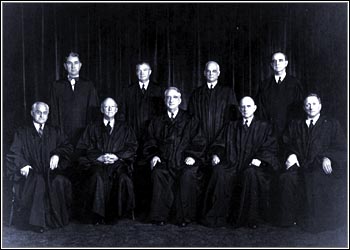
Brown v. Board of EducationAbout Brown v. Board |
Related Resources | Lesson Plans | Timeline of Desegregation and Civil Rights | Contact Us | Home
What Can I Do?
Brown et. al. v. Board of Education: A landmark Supreme Court case reversing the Court's decision in Plessy v. Ferguson , which allowed for segregated facilities for blacks and whites as long as they were theoretically equal. According to Plessy , separation based on race in transportation, and later, in education and all other public facilities, was lawful. After Plessy educational facilities for blacks in most southern states were always in separate schools and buildings but never equal. Salaries for black teachers, supplies for black schools, and transportation for black students were much inferior to those for whites. In many cases, such as high schools for blacks, no public facilities existed at all.
 |
Beginning in the 1930s, the National Association for the Advancement of Colored People (NAACP) challenged segregation in the Federal courts by trying to prove that existing state facilities for blacks were not equal to those for whites. Lawyers for the organization, especially Charles H. Houston and Thurgood Marshall , argued that equal education was a constitutional right of black Americans and essential to their legal equality and economic welfare. In the aftermath of World War II, the NAACP won several significant Court victories that opened state-supported graduate and law schools to black citizens. With these victories in hand, NAACP lawyers pressed on to attack the Plessy doctrine in elementary-level public schools. They initiated court cases simultaneously in Delaware, Kansas, South Carolina, Virginia, and Washington, D. C. When the cases reached the Supreme Court in December 1952, they were grouped under the Kansas case and thereafter were referred to as Brown v. Topeka Board of Education. The Court put the cases under Oliver Brown's suit in Kansas "so that the whole question would not smack of a purely southern one." They also took the five cases from different parts of the nation to avoid the argument that this was "Yankee justice" aimed at the southern way of life.
 |
In each of the five cases, local African-American parents worked with the local chapter of the NAACP to attempt to enroll their children in neighborhood schools. When they were told that they had to enroll their children in black schools, often in other neighborhoods, the parents sued the local boards of education. When state courts ruled in favor of the school boards, the parents appealed to the Supreme Court. In the Kansas case, 13 parents had joined together, and Oliver Brown, a local minister, was the first name listed.
In presenting their case before the Court, the NAACP lawyers made two interrelated points: First, they argued that the great physical and funding disparities between white and black schools provided overwhelming evidence that black children were denied equal educational opportunities. Second, the lawyers demonstrated the psychosocial damage done to black school children as a result of the Jim Crow system . In making this point, the lawyers drew upon the work of many influential social science scholars, especially the social psychologists Kenneth and Mamie Clark . They used a doll test to show the personality dysfunction resulting from Jim Crow among black children. When asked to choose between a white doll and a black doll, the children almost always took the white one. They argued that this simple test, along with others, showed the damage done to the black psyche as the Jim Crow system of segregation and racial bias reinforced notions of black inferiority and seriously damaged self-esteem among black children. Although such evidence set off a firestorm of controversy, the Court was clearly impressed by its value.
The victories won by the NAACP in earlier graduate and law school cases impacted relatively few people, but victory in the Brown case raised the fundamental question of segregation in a way that would affect almost every southern family. The case also fundamentally challenged the bedrock assumptions of white supremacy that had governed social relations between the races since the Civil War. Few cases in American history had such potential for altering the American way of life.
 |
As fate would have it, Earl Warren, the former Republican governor of California, became Chief Justice of a severely divided Supreme Court in 1953. His commitment and personal powers of persuasion enabled him to unite the Court in a historical ruling that completely reversed Plessy . Warren, speaking for a unanimous Court, held that "in the field of public education, the doctrine of 'Separate but equal' has no place." He further stated that the black children in the suits under review had been deprived, "by reason of the segregation claimed," of the equal protection of the laws guaranteed by the 14th Amendment. Separate facilities based on race were therefore "inherently unequal."
The Court did not expect the states to immediately desegregate their public schools, instructing them, in a later ruling in 1955, to "proceed with all deliberate speed" in implementing its order. As a result, the nation experienced a decade of delay, massive resistance, and violent confrontations, especially in the South. The resulting movement of popular protest and agitation in the 1950s and 1960s to achieve immediate desegregation of the nation's schools and all public facilities is known as the Civil Rights Movement. While it would be a mistake to think that the Civil Rights Movement began with Brown, it is correct to say that the Court's decision put the stamp of law upon the long and ongoing struggle for equality by African Americans. It was this legal stamp of approval that enabled the advocates of civil rights to demand and eventually obtain the Federal Government's assistance in their ongoing struggle for racial justice. Indeed, Brown set in motion the nation's most significant social transformation since the Civil War.
Source: From the online encyclopedia at the Jim Crow History website sponsored by New York Life.
Last update: